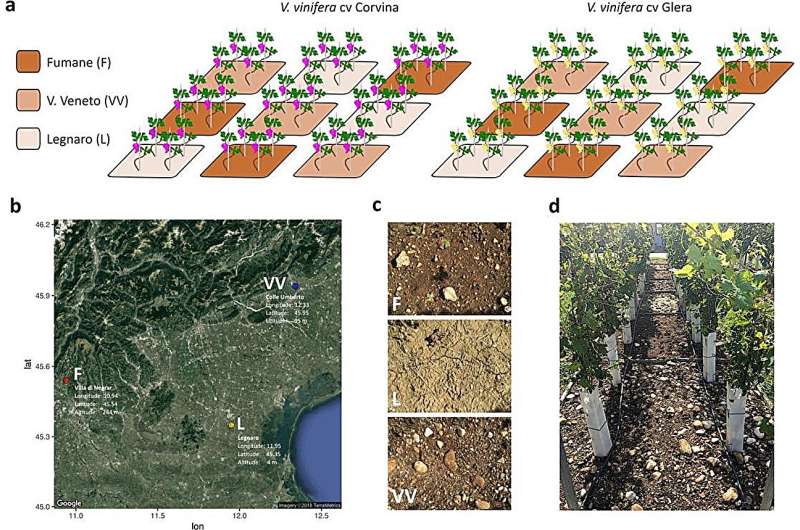This article has been reviewed according to Science X's editorial process and policies. Editors have highlighted the following attributes while ensuring the content's credibility:
fact-checked
trusted source
proofread
Unearthing the terroir effect: Grapevine's transcriptional response to soil variability

Grapevine is a globally significant fruit crop that exhibits remarkable phenotypic plasticity (PP) due to genotype-per-environment interactions (a concept known as terroir). This adaptability impacts physiological, molecular and biochemical aspects of the plant.
While soil and their properties are recognized influences on berry composition, there's limited knowledge about the molecular determinants governing these interactions. Recent studies have delved into grapevine's transcriptional plasticity, identifying "terroir signatures" and correlations between gene expression and metabolite accumulation. However, a challenge arises from the myriad of variables involved in field studies. For clearer insights, there's a pressing need to isolate factors influencing terroir and understand their interactions with grapevines.
In March 2023, Horticulture Research published a research paper titled "Dissecting the effect of soil on plant phenology and berry transcriptional plasticity in two Italian grapevine varieties (Vitis vinifera L.).."
In this study, researchers investigated the influence of different soils on the development of V. vinifera cv. Glera and Corvina grape varieties, two-year-old plants were transplanted into concrete caissons filled with soils from three wine-producing districts in Veneto, namely Fumane (F), Vittorio Veneto (VV), and Legnaro (L). The phenology of these plants was closely monitored in 2017 and 2018.
Findings indicated that both varieties had similar phenological development throughout the growing season, except during the early shoot development stage, where Glera showed a budburst about a week earlier than Corvina. Weather conditions, particularly temperature and rainfall, played a significant role in plant phenology.
As for physiological parameters, differences were observed in plants grown in various soils. In terms of molecular mechanisms, an mRNA-seq analysis was conducted, revealing transcriptional plasticity in response to different soils. Glera showed a more plastic transcriptional response compared to Corvina. However, Corvina's response was more focused on specific pathways of secondary metabolism.
The study employed a three-step data-mining strategy to find the most important links between variables in the RNAseq dataset, focusing on how stage, breed, tissue, and soil (and their interactions) affect gene expression.
First, 30,661 genes of the grapevine genome were screened, through which 22,503 genes were discarded due to inadequate profiles, and then the remaining 8,158 genes were k-means clustered, eventually reducing them to 102 clusters. These clusters represented genes with similar expression patterns across various experimental conditions, covering roughly 80% of the total gene expression variance.
A gradient boosting machine (GBM) was then utilized in the third step to determine the impact of variables such as stage, cultivar, tissue, and soil on gene expression patterns. By using of Variable Importance Measures (VIMs), the study successfully described associations between gene clusters and experimental conditions.
Furthermore, using Principal Component Analysis (PCA), the research discerned associations between the variables and 36 experimental conditions. The results indicated that stage, cultivar, and tissue were significant factors influencing gene expression. When delving deeper into transcriptional levels, soil was found to play a crucial role in GxS interactions.
Analysis of the top 30 clusters, accounting for about 70% of the total variance, revealed the functional categories affected by soil. Additionally, certain genes exhibited higher expression in the Corvina cultivar compared to Glera. Moreover, an examination of the promoter sequences of these soil-impacted genes identified a specific motif targeted by the transcription factor VvMYB03.
The research emphasized the transcriptional plasticity arising from the interaction between soil and other variables. Notably, the interplay between the phenological stage and soil composition had a pronounced influence on berry transcriptomic plasticity. Other interactions, such as those between soil and tissue variables, are linked to processes such as photosynthesis and chlorophyll metabolism.
In summary, this study illuminates the nuanced interactions of various factors on grapevine gene expression, with soil emerging as a crucial variable in GxS interactions. These insights pave the way for optimized agricultural practices, enabling targeted cultivation to enhance desired characteristics based on soil and cultivar combinations, thereby improving vineyard management and maximizing the terroir effects.
More information: Alessandro Vannozzi et al, Dissecting the effect of soil on plant phenology and berry transcriptional plasticity in two Italian grapevine varieties (Vitis vinifera L.)., Horticulture Research (2023). DOI: 10.1093/hr/uhad056
Provided by NanJing Agricultural University




















